PONTIAC GRAND AM 1998 Manual Online
Manufacturer: PONTIAC, Model Year: 1998, Model line: GRAND AM, Model: PONTIAC GRAND AM 1998Pages: 370, PDF Size: 16.11 MB
Page 81 of 370
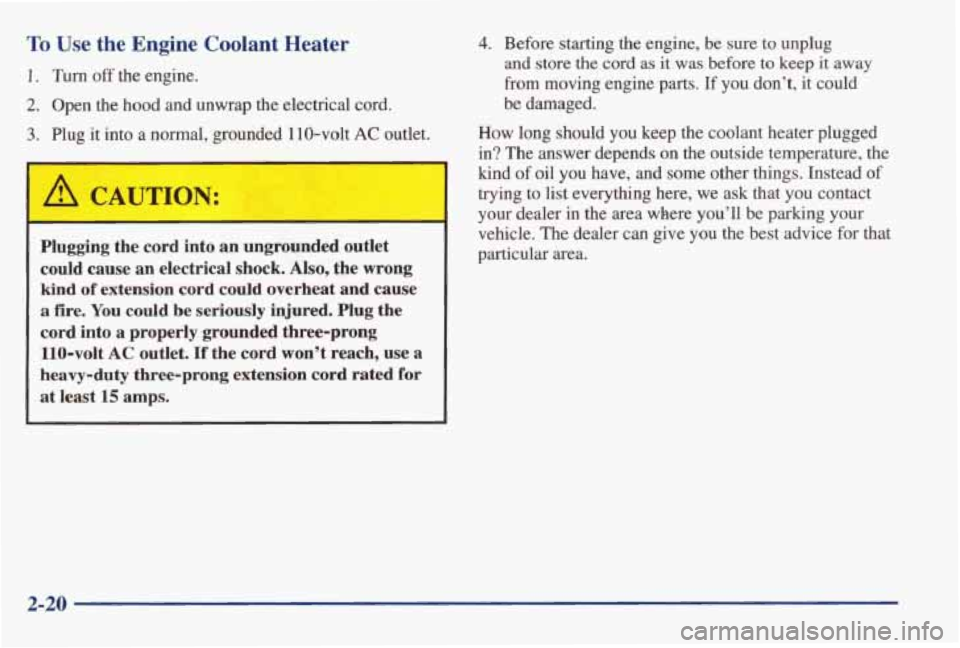
To Use the Engine Coolant Heater
1. Turn off the engine.
2. Open the hood and unwrap the electrical cord.
3. Plug it into a normal, grounded 110-volt AC outlet.
A CAUTION:
Plugging the cord into an ungrounded outlet
could cause an electrical shock. Also, the wrong
kind of extension cord could overheat and cause
a fire. You could be seriously injured. Plug the
cord into a properly grounded three-prong 110-volt
AC outlet. If the cord won’t reach, use a
heavy-duty three-prong extension cord rated for
at least 15 amps.
4. Before starting the engine, be sure to unplug
and store the cord as it was before to keep it away
from moving engine parts. If you don’t, it could
be damaged.
How long should you keep the coolant heater plugged
in? The answer depends on
the outside temperature, the
kind
of oil you have, and some other things. Instead of
, trying to list everything here, we ask that you contact
your dealer in the area where you’ll be parking
your
vehicle. The dealer can give you the best advice for that
particular area.
2-20
Page 82 of 370
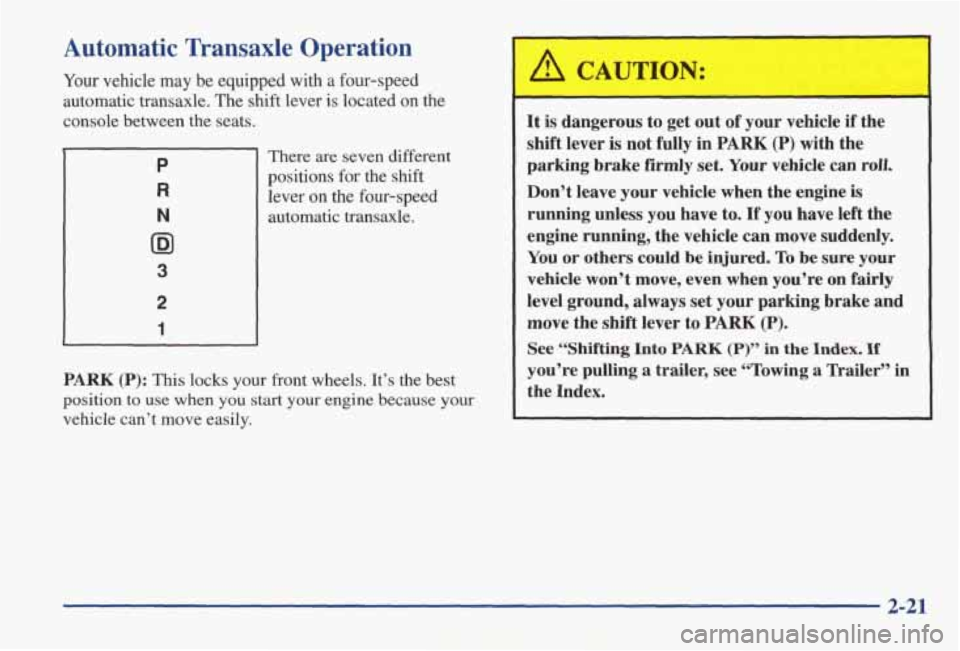
Automatic Transaxle Operation
Your vehicle may be equipped with a four-speed
automatic transaxle. The
shift lever is located on the
console between the seats.
There are seven different
positions for the shift
lever
on the four-speed
N
@I
3
2
1
automatic transaxle.
PARK (P): This locks your front wheels. It’s the best
position
to use when you start your engine because your
vehicle can’t move easily.
A CAUTION:
It is dangerous to get out of your vehicle if the
shift lever is
not fully in PARK (P) with the
parking brake firmly set. Your vehicle can roll.
Don’t leave your vehicle when the engine is
running unless you have to.
If you have left the
engine running, the vehicle can move suddenly.
You or others could be injured. To be sure your
vehicle won’t move, even when you’re on fairly
level ground, always set your parking brake and
move the shift lever to PARK (P).
See “Shifting Into PARK (P)” in the Index. If
you’re pulling a trailer, see “Towing a Trailer’’ i~
the Index.
2-21
Page 83 of 370
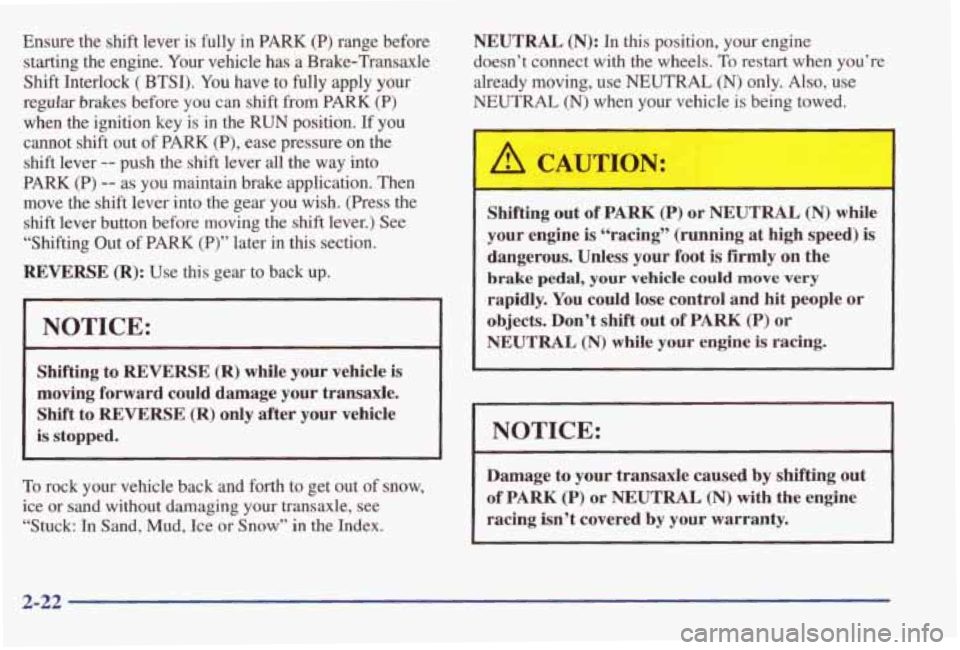
Ensure the shift lever is fully in PARK (P) range before
starting the engine. Your vehicle has a Brake-Transaxle
Shift Interlock
( BTSI). You have to fully apply your
regular brakes before you can shift from PARK (P)
when the ignition key is in the RUN position. If you
cannot
shift out of PARK (P), ease pressure on the
shift lever
-- push the shift lever all the way into
PARK (P) -- as you maintain brake application. Then
move the shift lever into the gear you wish. (Press the
shift lever button before moving the shift lever.) See
“Shifting Out of
PARK (P)” later in this section.
REVERSE (R): Use this gear to back up.
I 1
NOTICE:
Shifting to REVERSE (R) while your vehicle is
moving forward could damage
your transaxle.
Shift to REVERSE (R) only after your vehicle
is stopped.
To rock your vehicle back and forth to get out of snow,
ice or sand without damaging your transaxle, see
“Stuck: In Sand, Mud, Ice
or Snow” in the Index.
NEUTRAL (N): In this position, your engine
doesn’t connect with the wheels.
To restart when you’re
already moving, use
NEUTRAL (N) only. Also, use
NEUTRAL (N) when your vehicle is being towed.
I
Shifting out of PARK (P) or NEUTRAL (N) while
your engine is “racing” (running at high speed) is
dangerous. Unless your foot is firmly on the
brake pedal, your vehicle could move very
rapidly. You could lose control and hit people or
objects. Don’t shift out of PARK (P) or
NEUTRAL (N) while your engine is racing.
NOTICE:
Damage to your transaxle caused by shifting out
of PARK (P) or NEUTRAL (N) with the engine
racing isn’t covered
by your warranty.
2-22 -~
Page 84 of 370
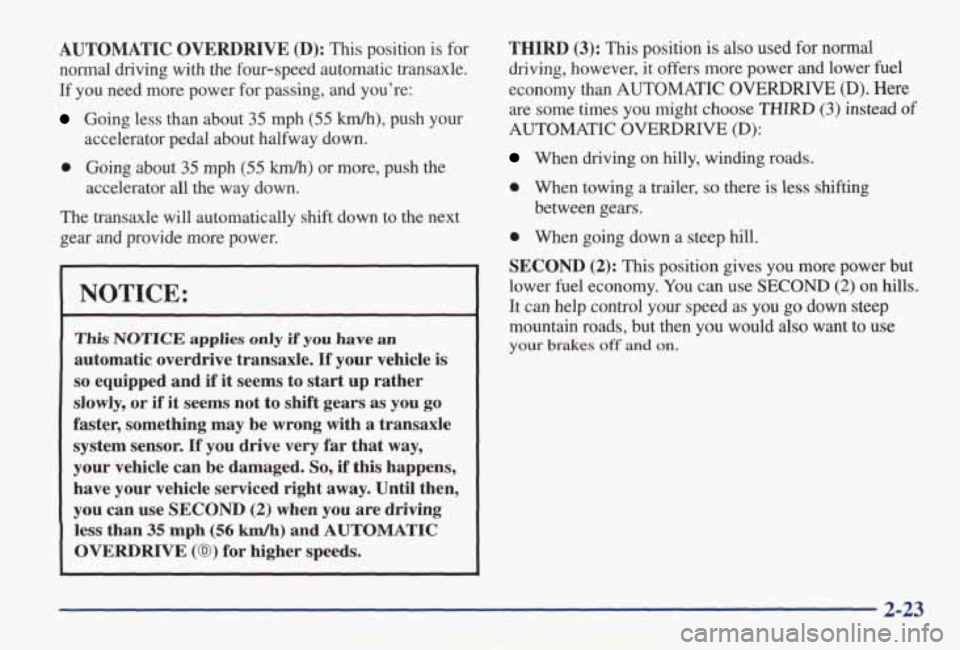
AUTOMATIC OVERDRIVE (D): This position is for
normal driving with the four-speed automatic transaxle.
If you need more power for passing,
and you’re:
Going less than about 35 mph (55 km/h), push your
0 Going about 35 mph (55 km/h) or more, push the
The transaxle will automatically shift down to the next
gear and provide more power. accelerator pedal about halfway down.
accelerator all the way down.
NOTICE:
This NOTICE applies only if you have an
automatic overdrive transaxle. If your vehicle is
so equipped and if it seems to start up rather
slowly,
or if it seems not to shift gears as you go
faster, something may be wrong with a transaxle
system sensor.
If you drive very far that way,
your vehicle can be damaged. So, if this happens,
have your vehicle serviced right away. Until then,
you can use SECOND
(2) when you are driving
less than
35 mph (56 km/h) and AUTOMATIC
OVERDRIVE (0) for higher speeds. THIRD
(3): This
position is also used for normal
driving, however, it offers more power and lower fuel
economy than AUTOMATIC
OVERDRIVE (D). Here
are some times you might choose THIRD (3) instead of
AUTOMATIC
OVERDRIVE (D):
When driving on hilly, winding roads.
0 When towing a trailer, so there is less shifting
between gears.
0 When going down a steep hill.
SECOND
(2): This position gives you more power but
lower fuel economy. You can use
SECOND (2) on hills.
It can help control your speed
as you go down steep
mountain roads, but then you would also want
to use
your brakes off and on.
2-23
Page 85 of 370
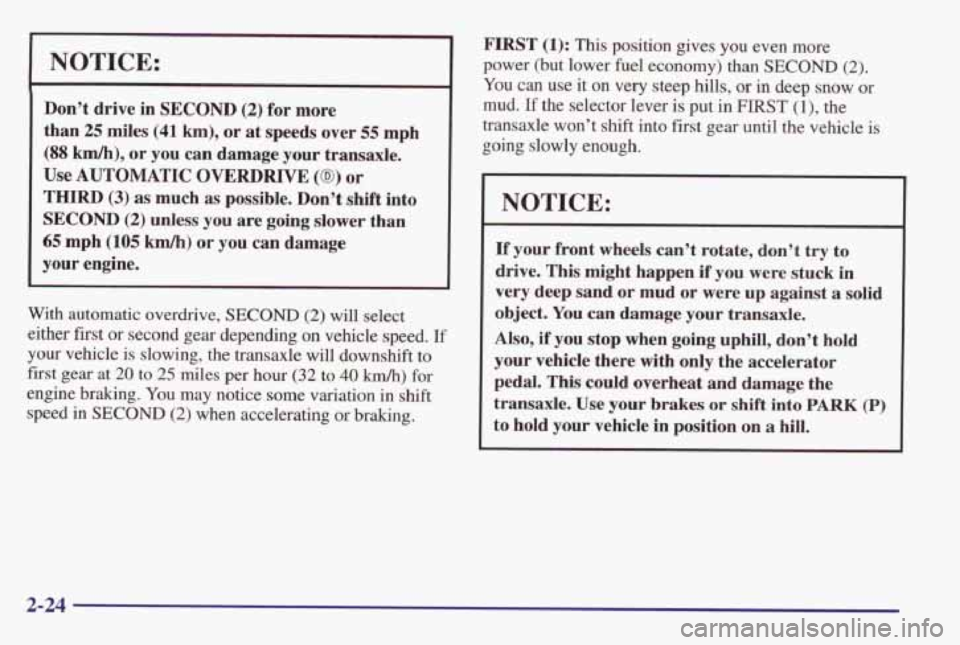
NOTICE:
Don’t drive in SECOND (2) for more
than
25 miles (41 km), or at speeds over 55 mph
(88 km/h), or you can damage your transaxle.
Use AUTOMATIC OVERDRIVE (0) or
THIRD (3) as much as possible. Don’t shift into
SECOND (2) unless you are going slower than
65 mph (105 km/h) or you can damage
your engine.
With automatic overdrive, SECOND (2) will select
either first or second gear depending
on vehicle speed. If
your vehicle is slowing, the transaxle will downshift to
first gear at 20 to 25 miles per hour (32 to 40 km/h) for
engine braking. You may notice some variation in shift
speed in SECOND (2) when accelerating or braking.
FIRST (1): This position gives you even more
power (but lower fuel economy) than SECOND (2).
You can use it on very steep hills, or in deep snow or
mud.
If the selector lever is put in FIRST (l), the
transaxle won’t
shift into fist gear until the vehicle is
going slowly enough.
NOTICE:
If your front wheels can’t rotate, don’t try to
drive. This might happen if you were stuck in
very
deep sand or mud or were up against a solid
object.
You can damage your transaxle.
Also, if you stop when going uphill, don’t hold
your vehicle there with only the accelerator
pedal.
This could overheat and damage the
transaxle. Use
your brakes or shift into PARK (P)
to hold your vehicle in position on a hill.
2-24
Page 86 of 370
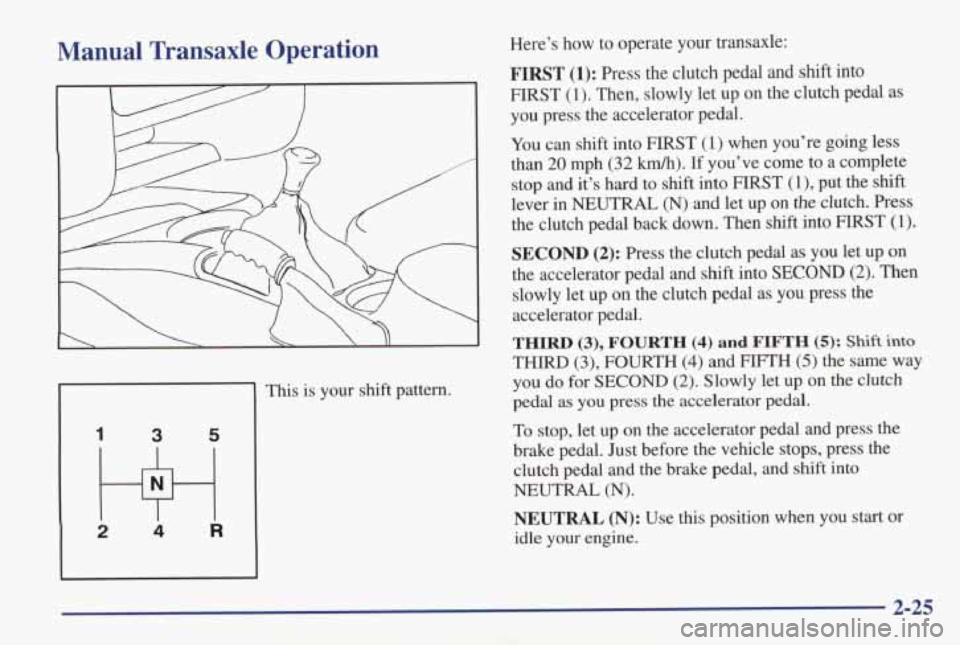
Manual Transaxle Operation
k
This is your shift pattern.
3 5
2 w 4 R
Here’s how to operate your transaxle:
FIRST (1): Press the clutch pedal and shift into
FIRST
(1). Then, slowly let up on the clutch pedal as
you press the accelerator pedal.
You can shift into FIRST
(1) when you’re going less
than
20 mph (32 kmh). If you’ve come to a complete
stop and it’s hard to shift into FIRST
(l), put the shift
lever in NEUTRAL (N) and let up on the clutch. Press
the clutch pedal back down. Then shift into FPRST
(1).
SECOND (2): Press the clutch pedal as you let up on
the accelerator pedal and shift into
SECOND (2). Then
slowly let up
on the clutch pedal as you press the
accelerator pedal.
THIRD(3),FOURTH(4)andFIFTH(5): Shift into
THIRD (3), FOURTH (4) and FIFTH (5) the same way
you do for
SECOND (2). Slowly let up on the clutch
pedal as you press the accelerator pedal.
To stop, let up on the accelerator pedal and press the
brake pedal. Just before the vehicle stops, press the
clutch pedal and
the brake pedal, and shift into
NEUTRAL
(N).
NEUTRAL (N): Use this position when you start or
idle your engine.
2-25
Page 87 of 370
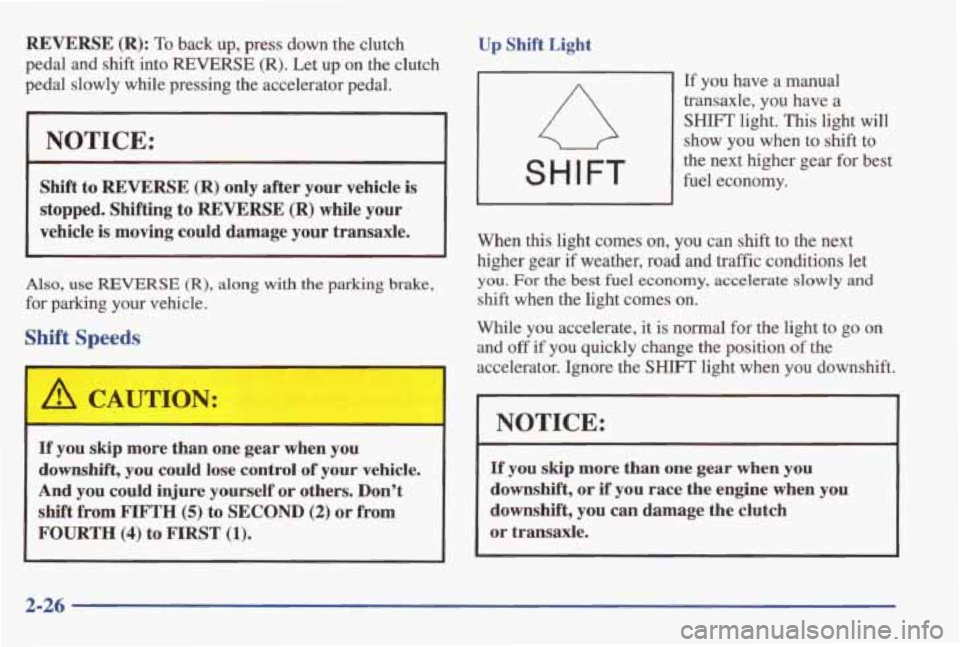
REVERSE (R): To back up, press down the clutch
pedal and
shift into REVERSE (R). Let up on the clutch
pedal slowly while pressing the accelerator pedal.
NOTICE:
Shift to REVERSE (R) only after your vehicle is
stopped.
Shifting to REVERSE (R) while your
vehicle is moving could damage your transaxle.
Also, use REVERSE (R), along with the parking brake,
for parking your vehicle.
Shift Speeds
A CAUTION:
If you skip more than one gear when you
downshift, you could lose control of your vehicle.
And you could
injure yourself or others. Don’t
shift from FIFTH (5) to SECOND (2) or from
FOURTH (4) to FIRST (1).
Up Shift Light
SHIFT
If you have a manual
transaxle, you have a
SHIFT light. This light will
show you when to
shift to
the next higher gear for best
fuel economy.
When this light comes on,
you can shift to the next
higher
gear if weather, road and traffic conditions let
you. For the best fuel economy, accelerate slowly and
shift when the light comes on.
While you accelerate, it is normal for the light to go on
and
off if you quickly change the position of the
accelerator. Ignore the
SHIETT light when you downshift.
NOTICE:
If you skip more than one gear when you
downshift, or if you race the engine when you
downshift, you
can damage the clutch
or transaxle.
2-26
Page 88 of 370
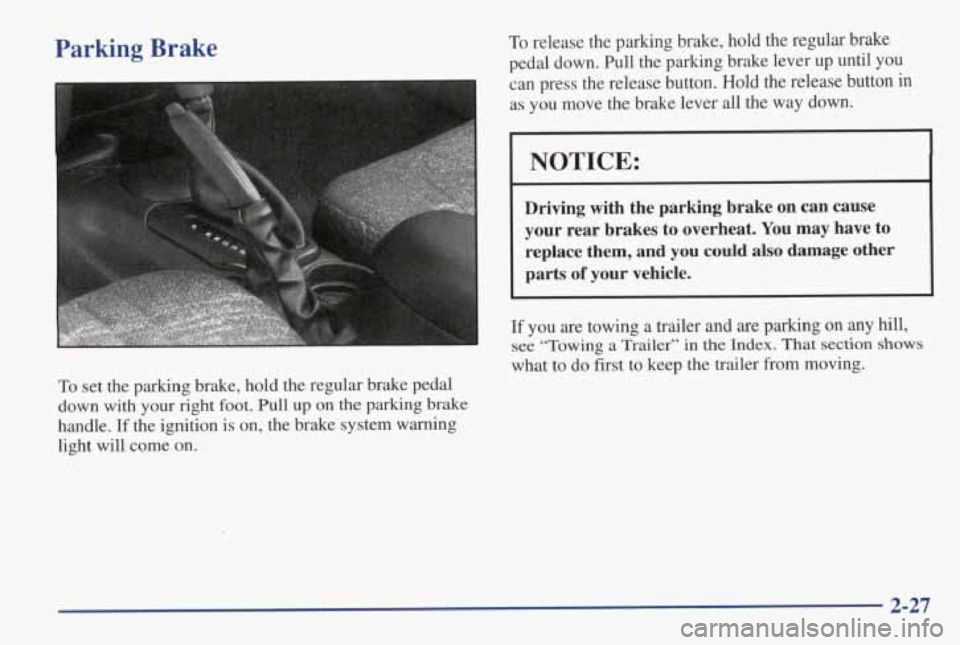
Parking Brake
To set the parking brake, hold the regular brake pedal
down
with your right foot. Pull up on the parking brake
handle. If the ignition is on, the brake system warning
light will come on.
To release the parking brake, hold the regular brake
pedal down. Pull the parking brake lever up until you
can press the release button. Hold the release button in as you move the brake lever all the way down.
Driving with the parking brake on can cause
your rear brakes to overheat. You may have to replace them, and you could also damage other
parts
of your vehicle.
If you are towing a trailer and are parking on any hill,
see “Towing a Trailer” in the Index. That section shows
what to do first to keep the trailer from moving.
2-27
Page 89 of 370
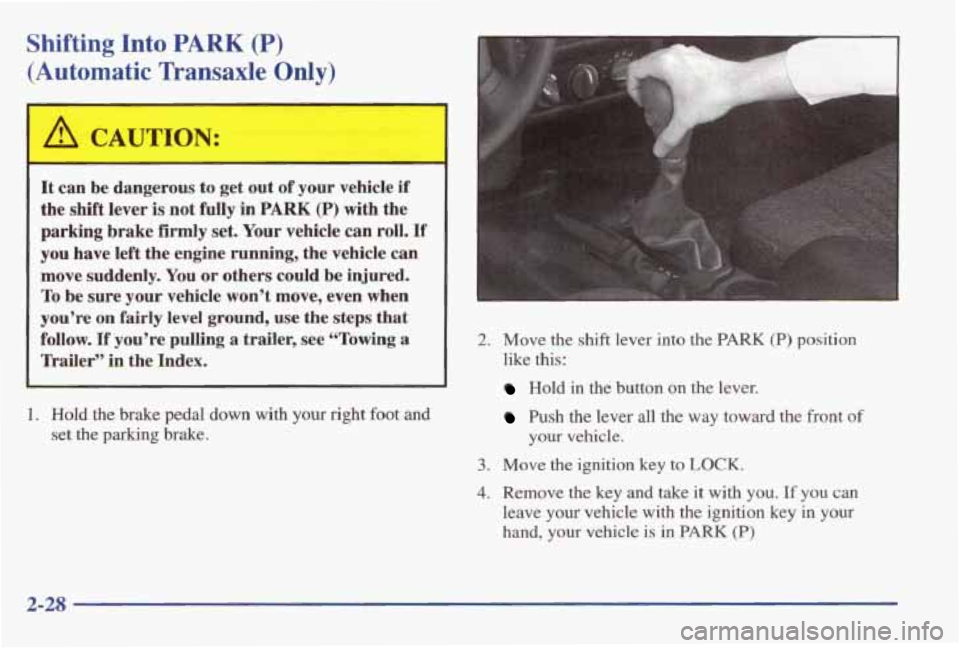
Shifting Into PARK (P)
(Automatic Transaxle Only)
A CAUTION:
It can be dangerous to get out of your vehicle if
the shift lever is not fully in PARK (P) with the
parking brake firmly set. Your vehicle can
roll. If
you have left the engine running, the vehicle can
move suddenly. You or others could
be injured.
To be sure your vehicle won't move, even when
you're on
fairly level ground, use the steps that
follow.
If you're pulling a trailer, see "Towing a
Tkailer" in the Index.
i
1. Hold the brake pedal down with your right foot and
set the parking brake.
2. Move the shift lever into the PARK (P) position
like this:
Hold in the button on the lever.
Push the lever all the way toward the front of
your
vehicle.
3. Move the ignition key to LOCK.
4. Remove the key and take it with you. If you can
leave your vehicle with the ignition key in your
hand, your vehicle is in
PARK (P)
2-28
Page 90 of 370
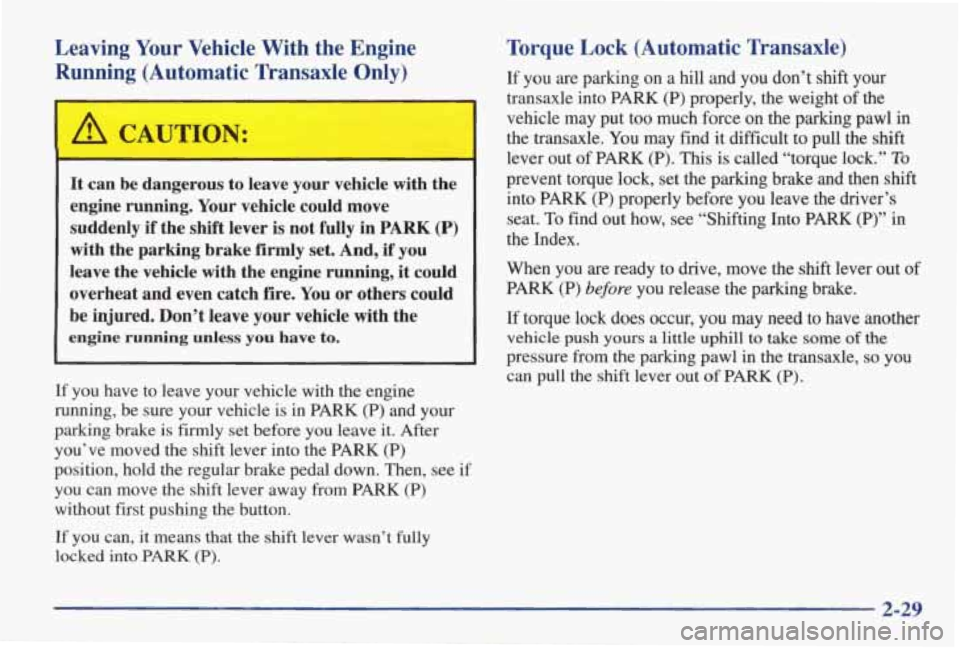
Leaving Your Vehicle With the Engine Running (Automatic Transaxle Only)
A CAUTION:
It can be dangerous to leave your vehicle with the
engine
running. Your vehicle could move
suddenly if the shift lever is not fully in
PARK (P)
with the parking brake firmly set. And, if you
leave the vehicle with the engine running, it could
overheat and even catch fire. You
or others could
be injured. Don’t leave your vehicle with the
engine running unless you have to.
If you have to leave your vehicle with the engine
running, be sure your vehicle is
in PARK (P) and your
parking brake is firmly
set before you leave it. After
you’ve moved the shift lever into the
PARK (P)
position, hold the regular brake pedal down. Then, see
if
you can move the shift lever away from PARK (P)
without first pushing the button.
If you can, it means that the shift lever wasn’t fully
locked into PARK (P).
Torque Lock (Automatic Transaxle)
If you are parking on a hill and you don’t shift your
transaxle into PARK (P) properly, the weight of the
vehicle may put too much force on the parking pawl
in
the transaxle. You may find it difficult to pull the shift
lever out of PARK (P). This is called “torque lock.” To
prevent torque lock, set the parking brake and then shift
into
PARK (P) properly before you leave the driver’s
seat.
To find out how, see ‘‘Shifting Into PARK (P)” in
the Index.
When you are ready to drive, move the shift lever out
of
PARK (P) before you release the parking brake.
If torque lock does occur, you may need to have another
vehicle push yours a little uphill to take some of the
pressure from the parking pawl in the transaxle, so you
can pull the shift lever out of
PARK (P).
2-29